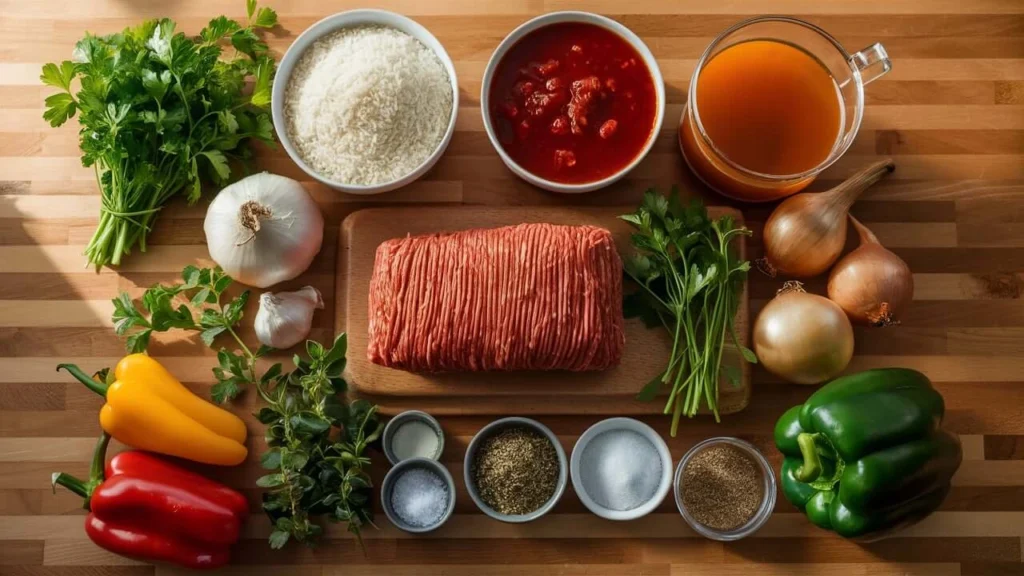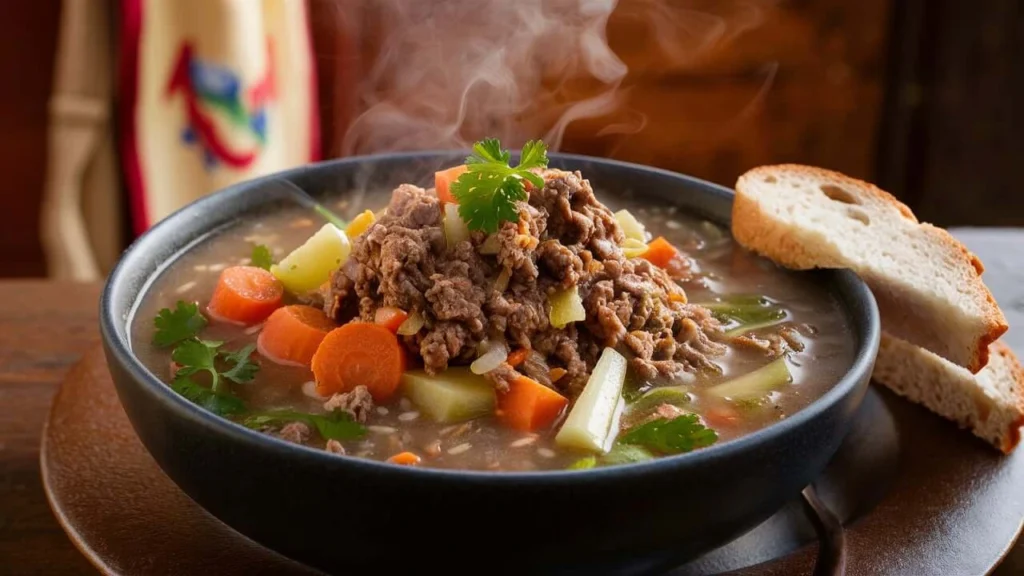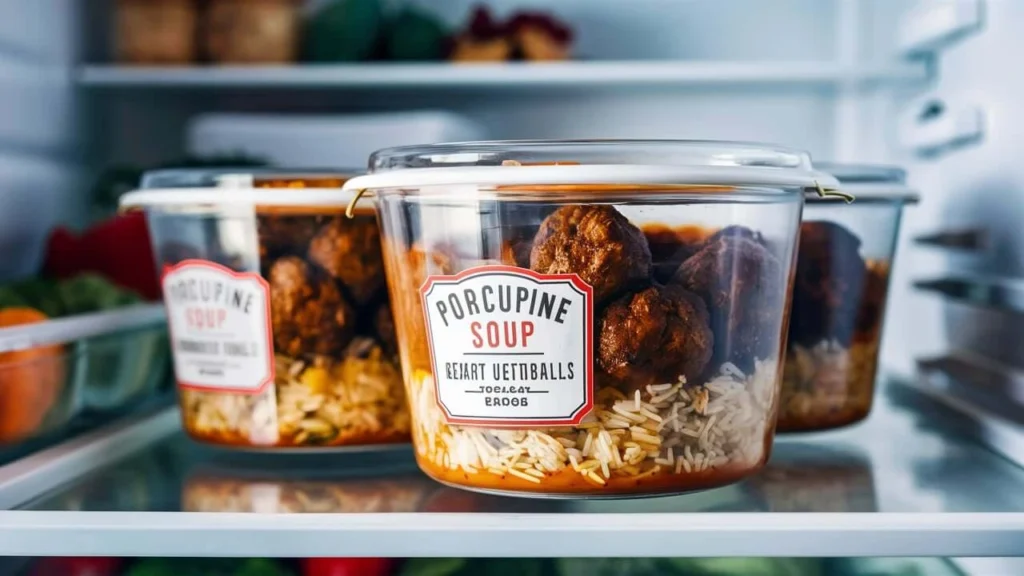Have you ever craved a warm, comforting bowl of soup that comes together in just 25 minutes? Porcupine Soup is the perfect answer—a hearty, flavor-packed dish featuring tender rice-stuffed meatballs simmered in a rich, savory tomato broth. This one-pot meal is a classic comfort food, combining simple ingredients like ground beef, white rice, and aromatic herbs to create a satisfying, family-friendly dinner. Whether you’re looking for a cozy weeknight meal or a nostalgic favorite with a twist, this quick and easy soup is sure to become a staple in your kitchen. Let’s dive into the recipe and bring this timeless dish to life.
What is Porcupine Soup?
If you love hearty, comforting meals that come together effortlessly, porcupine soup is a must-try dish. This classic recipe takes inspiration from porcupine meatballs—a beloved dish known for its unique texture and rich flavor. By transforming these rice-stuffed meatballs into a warm, savory soup, you get a dish that is even more comforting, packed with flavor, and perfect for chilly evenings.
Why is it Called “Porcupine” Soup?
Don’t worry—there’s no actual porcupine in this recipe! The name comes from the way the uncooked rice inside the meatballs expands as it cooks, causing small grains to poke out like tiny quills. This playful resemblance gave birth to the name porcupine meatballs, and when served in a rich, tomato-based broth, it becomes the deliciously cozy porcupine soup.
Key Ingredients That Make This Soup Special
What makes this dish stand out is its simple yet well-balanced combination of ingredients, each playing a key role in flavor and texture:
- Ground Beef – Provides a hearty, protein-rich base for the meatballs.
- White Rice – The signature ingredient that expands during cooking, giving the meatballs their unique texture.
- Tomato Sauce & Broth – A flavorful combination that creates a rich, savory soup base with a touch of acidity.
- Onion & Garlic – Essential aromatics that add depth and complexity to the dish.
- Seasonings & Herbs – A blend of oregano, basil, salt, black pepper, and Worcestershire sauce enhances the overall flavor.
A Comforting Twist on Classic Porcupine Meatballs
Traditional porcupine meatballs are typically baked or simmered in sauce, but this soup version takes the dish to the next level. By cooking the meatballs in a flavorful broth, the dish becomes more comforting, perfect for cold days or when you need a quick, nourishing meal. Plus, the extra liquid makes it easier to enjoy with crusty bread or a side of steamed vegetables.
With its rich flavor, hearty texture, and easy one-pot preparation, porcupine soup is a timeless dish that deserves a spot in your weekly meal rotation. Up next, let’s dive into the ingredients you’ll need to make this delicious soup at home.
Ingredients You’ll Need
Crafting a delicious bowl of porcupine soup starts with the right ingredients. This dish combines simple pantry staples to create a rich, comforting meal with well-balanced flavors. Below is a breakdown of the essential components that bring this classic soup to life.

Key Ingredients for Porcupine Soup
| Ingredient | Purpose in the Recipe |
| Ground Beef | Adds richness and protein, forming the base of the meatballs. |
| White Rice | Absorbs liquid as it cooks, creating the signature “porcupine” texture. |
| Tomato Sauce | Provides a tangy depth of flavor and blends into a smooth broth. |
| Beef Broth | Enhances the soup’s savory notes while keeping it hearty. |
| Onion & Garlic | Build a deep, aromatic base for both the broth and meatballs. |
| Bell Peppers | Add sweetness and a slight crunch for extra texture. |
| Oregano & Basil | Classic Italian-style herbs that elevate the overall flavor. |
| Worcestershire Sauce | A touch of umami to enhance the depth of the broth. |
| Black Pepper & Salt | Essential seasonings to balance all the flavors. |
Ingredient Substitutions and Variations
Want to customize your porcupine soup? Here are some easy ingredient swaps to tailor the recipe to your preferences:
- Lighter Version – Use ground turkey or chicken instead of beef for a leaner option.
- Different Broth Base – Swap beef broth for chicken or vegetable broth for a milder flavor.
- Rice Alternatives – Try brown rice for added fiber, but note that it may require a longer cooking time.
- Extra Hearty Soup – Add carrots, celery, or diced potatoes to boost texture and nutrition.
- Spicy Kick – A pinch of red pepper flakes or a splash of hot sauce can bring some heat to the broth.
With these ingredients and variations, you can easily create a customized bowl of porcupine soup that fits your taste. Now that you have your ingredients ready, let’s move on to the step-by-step process of making this comforting dish.
How to Make Porcupine Soup (Step-by-Step Guide)
Creating a delicious porcupine soup is easier than you think! This step-by-step guide will walk you through the process, ensuring that every bite is filled with tender meatballs, flavorful broth, and comforting warmth.
1. Prepare the Meatballs
The heart of this soup is the porcupine meatballs, which get their signature texture from the rice.
- In a large bowl, combine:
- Ground beef (or turkey for a lighter version)
- Uncooked white rice (absorbs moisture as it cooks)
- Minced garlic and onion (for depth of flavor)
- Seasonings (salt, black pepper, oregano, and basil)
- Worcestershire sauce (adds a rich, savory touch)
- Mix until well combined, but don’t overwork the mixture—this helps keep the meatballs tender.
- Roll into small 1-inch meatballs and set aside.
2. Sauté the Aromatics
Before adding the broth, you’ll want to build a flavorful base.
- Add a splash of oil to a large pot and heat it over medium heat.
- Add diced onion, minced garlic, and chopped bell peppers.
- Cook for 2–3 minutes until softened and fragrant.
These aromatics infuse the soup with a rich, savory depth, making every spoonful incredibly satisfying.
3. Simmer the Soup
Now, it’s time to combine all the flavors.
- Pour in beef broth and tomato sauce.
- Stir in a dash of Worcestershire sauce for umami depth.
- Add oregano, basil, black pepper, and salt for seasoning.
- Bring to a gentle simmer, stirring occasionally.
Letting the soup simmer for a few minutes before adding the meatballs allows the flavors to meld together beautifully.
4. Cook the Meatballs
Now, for the final step—cooking the meatballs directly in the soup.
- Gently drop the prepared meatballs into the simmering broth.
- Cover and let cook for 20–25 minutes, or until the rice in the meatballs is tender.
- Stir occasionally to prevent sticking, but be gentle to keep the meatballs intact.
Once the porcupine meatballs are fully cooked, the soup is ready to serve! Garnish with fresh parsley and enjoy this comforting, hearty dish with a side of warm bread or crackers.
This easy, one-pot meal is perfect for busy weeknights or when you’re craving a bowl of nostalgic, home-cooked comfort. Now, grab a spoon and dig in. 🍲
Tips for the Best Porcupine Soup
A great porcupine soup is all about rich flavors, perfect textures, and thoughtful preparation. Follow these expert tips to make sure your soup turns out hearty, delicious, and packed with the best flavors.

1. Use Fresh Herbs for Enhanced Flavor
While dried herbs work well, fresh herbs like parsley, cilantro, or basil can elevate your soup’s taste. They add a burst of brightness that balances the rich tomato-based broth.
- Chopped fresh parsley is a classic garnish, adding a mild, slightly peppery flavor.
- Fresh cilantro gives the soup a slightly citrusy, herbal touch.
- Basil leaves bring an Italian-inspired depth to the dish.
Add herbs right before serving to preserve their vibrant flavor and color.
2. Let the Soup Simmer for Perfectly Cooked Meatballs
Since the rice inside the porcupine meatballs cooks as the soup simmers, patience is key.
- Simmering at a low-medium heat allows the meatballs to cook evenly without breaking apart.
- Stir the soup gently to prevent the meatballs from crumbling.
- If using brown rice instead of white, increase the cooking time to ensure the rice softens properly.
Letting the soup simmer also helps develop a deeper, richer taste, making every spoonful incredibly flavorful.
3. Make It Ahead for Even Better Flavor
Like many hearty soups and stews, porcupine soup tastes even better the next day. The extra time allows the flavors to meld together beautifully.
- Keep leftovers in an airtight container in the fridge for up to 3 days.
- Reheat gently on the stove or in the microwave, adding a bit of broth if necessary..
- The meatballs absorb more of the broth over time, making them even more flavorful.
If you’re planning for meal prep, this soup freezes well. Store in portioned containers and thaw overnight before reheating.
4. Customize the Soup for More Nutrition and Variety
This recipe is versatile, allowing you to add extra ingredients to suit your taste.
- For a heartier soup: Add diced potatoes or pasta to the broth.
- For extra nutrition: Stir in carrots, celery, or spinach for added vitamins and texture.
- For a spicy kick: A pinch of red pepper flakes or cayenne pepper can bring a little heat.
- For a lighter version: Use lean ground turkey instead of beef and swap beef broth for chicken or vegetable broth.
Final Thoughts
With these expert tips, your porcupine soup will be bursting with rich flavors, perfectly cooked meatballs, and comforting warmth. Whether you’re making it for a cozy weeknight meal or meal-prepping for the week, this one-pot classic is sure to become a family favorite.
👉 Now it’s your turn! Try these tips and let us know—what’s your favorite twist on porcupine soup? 🍲✨
Serving Suggestions & Storage Tips
Once you’ve perfected your porcupine soup, it’s time to think about how best to serve and store it. These practical tips will help you enjoy every bite and keep the flavors fresh for days to come.
Best Ways to Serve
Porcupine soup is a hearty, satisfying meal on its own, but pairing it with the right sides can take it to the next level. Here are a few ideas:
- Crusty Bread: A warm, crusty baguette or rustic loaf of bread is perfect for dipping into the rich broth.
- Garlic Toast: Garlic toast adds a delicious crunch and a savory flavor that complements the soup’s hearty meatballs.
- Simple Side Salad: A light, fresh side salad with a tangy vinaigrette is an excellent balance to the rich flavors of the soup.
These sides create a well-rounded meal that’s perfect for cozy nights at home or casual gatherings with family and friends.
Storage Tips for Leftovers
If you have any porcupine soup left over, don’t worry—it stores wonderfully! Here are a few tips to keep your leftovers fresh:

- In the Refrigerator: Store leftovers in an airtight container and refrigerate for up to 3 days. This will allow the flavors to continue to meld, making your soup even better the next day.
- In the Freezer: For longer storage, freeze your soup for up to 2 months. To prevent freezer burn, make sure to use a freezer-safe container and leave some space at the top to allow for expansion.
- Label Your Containers: Don’t forget to label your containers with the date you made the soup. That way, you’ll know exactly how fresh it is when you’re ready to reheat it.
How to Reheat Properly Without Overcooking the Meatballs
Reheating porcupine soup without overcooking the meatballs can be tricky, but these tips will help you do it just right:
- Stovetop Method: Reheat your soup over low to medium heat. Stir occasionally to ensure even warming, but be gentle with the meatballs to avoid breaking them apart. If the soup has thickened, add a splash of broth to reach your desired consistency.
- Microwave Method: If you’re using the microwave, place the soup in a microwave-safe container and cover it loosely with a microwave-safe lid. Reheat in 1-minute intervals, stirring gently after each interval to avoid overheating the meatballs.
By following these tips, you can enjoy your porcupine soup as if it were freshly made, no matter when you reheat it.
With these serving suggestions and storage tips, you’ll be able to enjoy your porcupine soup to the fullest, whether it’s a quick meal for yourself or shared with loved ones. Make sure to try different sides, store your leftovers properly, and reheat your soup with care for the perfect comfort food experience every time.
Conclusion
In conclusion, porcupine soup is the ultimate quick, hearty, and family-friendly meal. With its flavorful meatballs and savory broth, it’s the kind of dish that’s perfect for any season, whether you’re enjoying it on a chilly evening or serving it at a casual family dinner. The combination of tender meatballs, rice, and rich broth makes it a truly satisfying comfort food that everyone will love.
I encourage you to give this recipe a try and experience the deliciousness for yourself. It’s easy to make, customizable to your preferences, and guaranteed to be a hit with your loved ones.
Let me know in the comments how your porcupine soup turned out! I’d love to hear about your experience, any variations you tried, and how you served it. Happy cooking.
FAQs
1. What makes this soup called “porcupine soup”?
The name “porcupine” comes from the way the rice inside the meatballs protrudes, mimicking the spines of a porcupine. As the meatballs simmer in the soup, the rice expands, creating the look of spiky quills.
2. Can I use a different type of meat for the meatballs?
Absolutely! While ground beef is the classic choice, you can substitute it with ground turkey, chicken. The flavor may vary slightly, but the soup will still be delicious.
3. Is it possible to use brown rice instead of white rice?
Yes, you can use brown rice for a slightly nuttier flavor and added nutrition. Just keep in mind that it may take a little longer to cook, so adjust the simmering time accordingly.
4. Can I prepare this soup in advance?
Absolutely! Porcupine soup often tastes even better the next day as the flavors develop. Just store any leftovers in an airtight container in the fridge for up to 3 days, or freeze it for up to 2 months.
5. How do I reheat porcupine soup without overcooking the meatballs?
To reheat the soup, do so gently over low heat. Avoid boiling it, as this could cause the meatballs to become overcooked. If reheating from frozen, defrost the soup in the fridge overnight before reheating.

